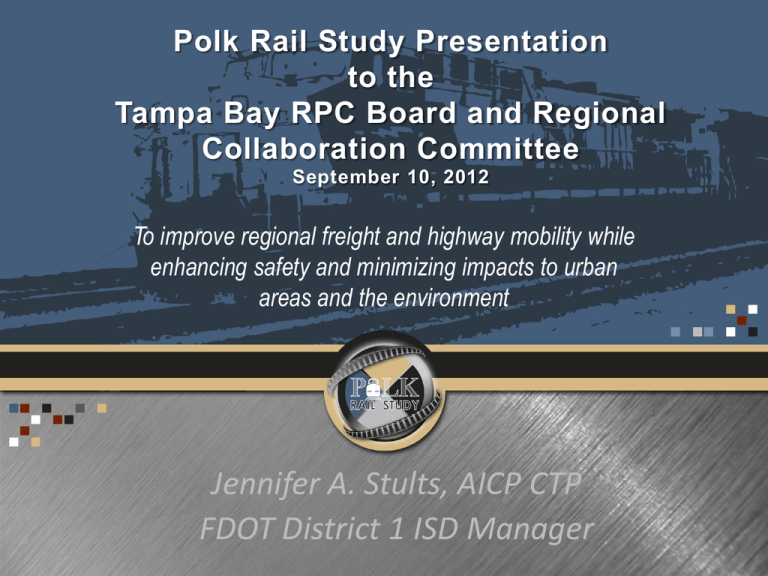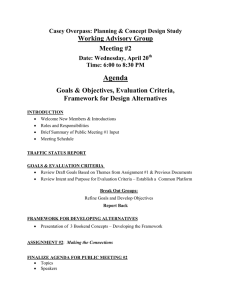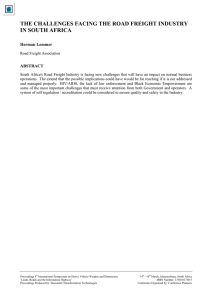Polk Rail Study Presentation to the Tampa Bay RPC Board and Regional
advertisement

Polk Rail Study Presentation to the Tampa Bay RPC Board and Regional Collaboration Committee September 10, 2012 To improve regional freight and highway mobility while enhancing safety and minimizing impacts to urban areas and the environment Jennifer A. Stults, AICP CTP FDOT District 1 ISD Manager 1 Alternatives Map 2 Initial Study Conclusions Common Issues for All Relocation Alternatives Freight continues to operate through urban areas Local trains continue to operate on the “A” and “S” lines Through trains would divert to an alternate route CSX would have to agree to move operations to any new route Infrastructure improvements still required on “S” line to serve the ILC Lakeland area track sidings Numerous rail signal upgrades Pollard Road construction to the ILC 3 Initial Study Conclusions Common Issues for All Relocation Alternatives Potentially shifts impacts to other communities Significant infrastructure costs Property acquisition required Increases operations and maintenance costs Significant environmental challenges 4 5 Steps Phase 2 Phase 1 STEP STEP 1 2 STEP Scenario Development • • • • • Data Collection Traffic Freight Demand Safety Environmental Concerns • Noise and Vibration 1 4 STEP • Finalize Short Term Solutions • Funding and Finance • Identify Viable Long Term Solutions 2 Phase II Alt. Analysis • Criteria and Methodology • Rail Operations • Community Issues • Agency Issues • Evaluation of alternatives • Cost/Benefit 5 Recommendations Refine Viable Alternatives Refine Solutions Coordination • Goals • Issues • Freight and Stakeholders Taskforce • Mayors Council 3 STEP • Alternatives to advance to PD&E • Funding Plan • Preferred Package • Implementation Plan Long Term Federal Action (EA/EIS) Short Term (SEIR/Cat Ex) Early Start Projects 4 3 Early Start = Before SunRail Short Term = 5+ years Long Term NTP 6 MONTHS 9 MONTHS 12 MONTHS 15 MONTHS 18 MONTHS 5 Public Outreach Opportunities Freight and Stakeholders Taskforce (FAST) – Comprised of government staff and project stakeholders – Meet regularly – Develop and refine short term and long term projects Mayors Council – – – – Comprised of study area Mayors Predominantly meet via webinar Identify community concerns Project champions Environmental Advisory Group (EAG) – Consists of regulatory agencies – Discuss environmental issues along corridors – Feed information to FAST and Mayors Council 6 Short Term Solutions We currently have several concepts under development Quiet Zones Noise abatement Geometric track improvements Grade separations Rail signal preemptions 7 Quiet Zones Quiet zones FRA program Grade crossings may need to be closed 8 Geometric Track Improvements CSX land ownership Increased speed Less “gate down” time Existing Rail Realignment Option 9 Grade Separations 10 Bicycle/Pedestrian Accommodations 11 Trenching 12 Signal Pre-emption 13 Public Meetings • September 10, 2012 at the Lakeland Center • September 11, 2012 at Fantasy of Flight, Polk City • September 13, 2012 at the Bartow Civic Center • 5 pm to 7 pm each night, formal presentation at 6 pm 14 Summary Looking at short and long term solutions Project will involve extensive public outreach Input and participation throughout – FAST (Freight and Stakeholders Taskforce) – Mayors Council – Agency Coordination – Public Meetings 15 Questions? Gwen Pipkin, Sr. Project Manager 863-519-2375 gwen.pipkin@dot.state.fl.us 16



